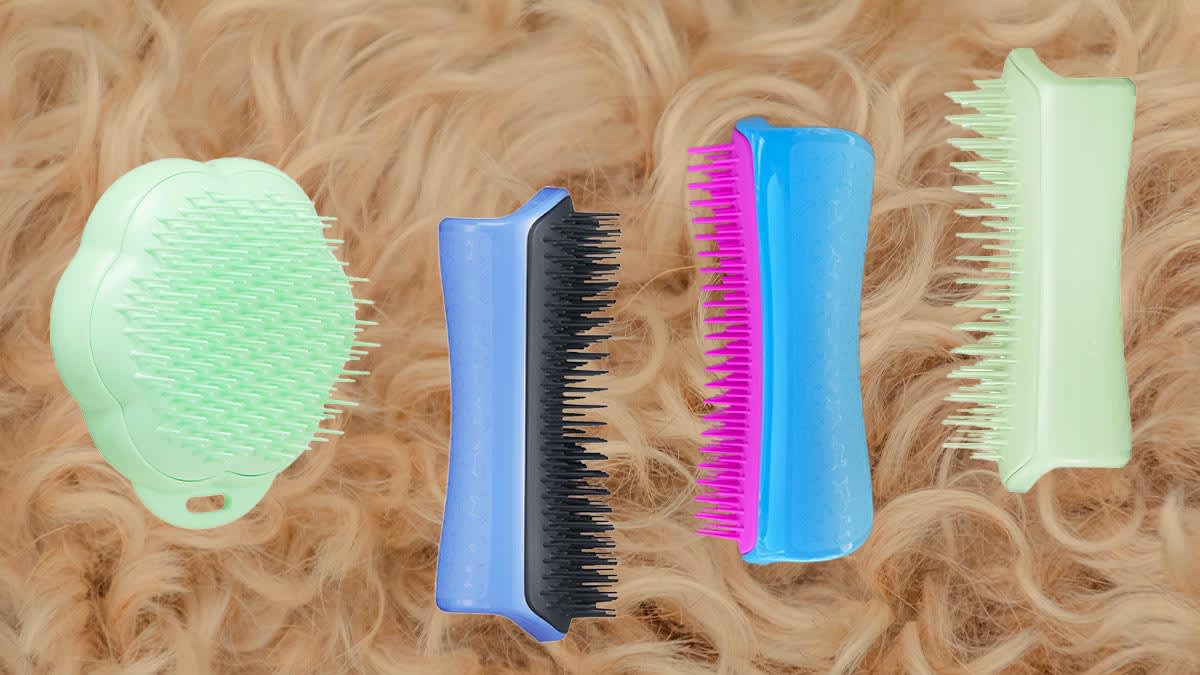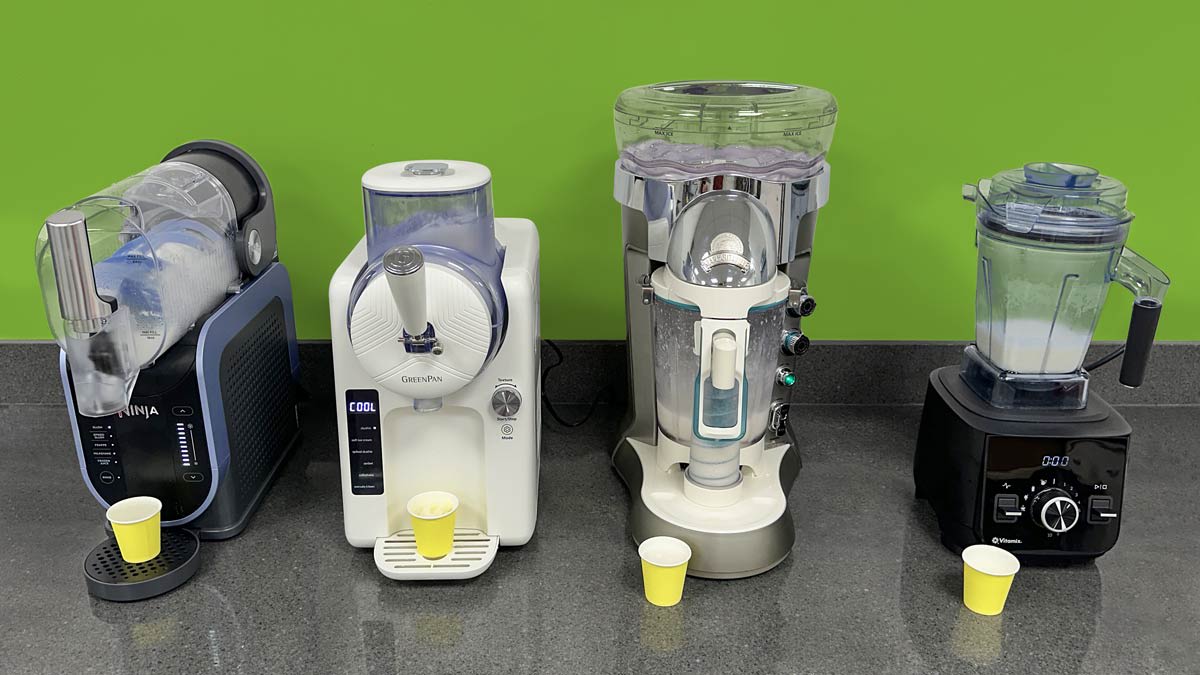We Tried It: Tangle Teezer Cat and Dog Brushes

Tangle Teezer’s Ultimate Detangler was one of our favorite detangling brushes. Are its pet brushes just as good?
Tangle Teezer’s four pet brush options can be used on wet and dry hair, according to the company.
By Jodhaira Rodriguez
With my own cat at home, I am constantly picking hair off of everything—hard and soft surfaces alike. I find that when I skip brushing my cat’s hair too many days in a row, Frank leaves more hair behind on his favorite nap spot, the couch, and I have to spend more time lint-rolling my clothes before I go out.
For this reason, I try to keep to a daily brushing schedule most of the time.
Dog owners know that regular brushing in between grooming appointments is important to keep hair from becoming matted. This will not only make appointments with the groomer go a lot smoother but also keep your dogs looking picture-perfect.
But not all pet brushes are made the same, and one that works for one fur baby may not work for another. I went through four different brushes before I finally found one that my cat and I both liked.
Tangle Teezer, the maker of one of the human detangling brushes we recommend, recently released four pet brushes. We bought them (like we buy all of the products we test), sent them home with a few of our colleagues who have pets, and had our colleagues report back on their experience.
Tangle Teezer Cat Grooming Brush

What I liked: My cat, Frank, is an American shorthair, but he sheds a full-grown cat’s worth of hair every week around my apartment, so brushing is a daily activity for us as I try to minimize the amount of hair I have to clean off my floors. He loves his brushing sessions and will usually let me get every part of him except his belly. Frank seemed as comfortable with the Tangle Teezer Cat Brush as with his usual brush. The Tangle Teezer didn’t cause any pain or discomfort, even on the more sensitive parts of his body like around his ears and under his chin.
Cleaning the brush of the bit of hair that it picked up was easy. It all came off in one large clump when I pulled at it.
What I didn’t like: The brush removed a large amount of hair from my cat’s coat with each pass, but after a few minutes, I noticed that instead of picking up all of the hair, most of it was just collected into small clumps that then sat on top of his body. I could see the clumps floating off his body and into the air while I brushed. After I was done brushing him, these small clumps of hair were all over my floor and couch and stuck to my clothes. I never have this problem with his usual brush. Clumped hair is easier to spot and clean up than all of the loose hair that usually lives around my apartment, but I didn’t like having to vacuum right after every brushing session.
Though Frank found the brush comfortable, I didn’t. The brush’s pawlike shape made it hard to keep a firm grip on. The brush I normally use on my cat has a long handle that is much more comfortable.
Would I recommend this to another cat parent? Unfortunately, no. My cat was happy with the brush, but the extra cleaning I had to do made it not worth it for me.
Tangle Teezer De-Shedding Dog Grooming Brush

CR’s senior director of product and design Brandy Collins used this brush with her Brussels griffon, Doodah, who usually gets brushed every couple of months with a comb that is supposed to get through her undercoat.
What she liked: Brandy found that the de-shedding brush was easy to hold while she used it and cleaning the hair off after using was easy, too.
What she didn’t like: According to Brandy, her dog is not a fan of grooming time, and this brush didn’t seem to improve the process compared with her usual brush. Because Doodah is a smaller pup, the size of the Tangle Teezer brush made it difficult to reach around the dog’s small neck.
Would she recommend this to another pet parent? Brandy says no. She didn’t think it worked as well as her usual brush.
Tangle Teezer Puppy Brush

Lauren Kiesel, a senior user experience researcher at CR, tried this brush on her cockapoo (cocker spaniel and poodle mix) puppy, Benny, who gets brushed every couple of days and after every bath. She usually uses the same self-cleaning brush I use on my cat.
What she liked: Lauren liked that the bristles on the Tangle Teezer Puppy Brush were gentle. “I felt safe brushing his furry face without having to be too delicate, like I am used to with other brushes I’ve tried.” She also liked that the brush’s shape allowed her to have different grip options on the handle.
Benny seemed not to mind being brushed by the Puppy Brush. He tried to nibble it a few times, but Lauren couldn’t be sure whether it was due to the brush or some other factor.
What she didn’t like: Though Lauren found that the brush could get through light tangles in Benny’s long fur, it couldn’t handle a more intensive mat on his leg. To tackle that, Lauren had to pull out the wire brush she currently owns.
Would she recommend this to another pet parent? Even though Lauren and Benny didn’t prefer this brush overall to their usual grooming tool, Lauren would still recommend it to a friend, if it fit the bill for their need.
Tangle Teezer Detangling Dog Grooming Brush

If the Tangle Teezer Detangling Brush has just one fan, it’s CR writer Lisa Fogarty’s curly-haired labradoodle, Blake. He’s usually brushed about once a week with a 2-in-1 combo brush.
What she liked: Lisa says, “This brush is currently Blake’s favorite thing in the world. I say, ‘Do you want to be brushed?’ and he comes running to me.” It’s the first time he has ever reacted with excitement to being brushed, according to Lisa. Even when his ears, which get very curly, are being brushed, Blake remains calm.
Lisa found the brush easy to hold in the palm of her hand. The brush’s width was also helpful in detangling Blake’s fur quickly. Other brushes she’s used on her dog have been narrower with fewer bristles, which makes grooming time a longer chore than she’d like. She found that the small bit of hair the Tangle Teezer Detangling Brush picked up off of Blake was easy to remove from the brush when she was done using it.
What she didn’t like: Blake doesn’t shed much, so Lisa didn’t think this was a big deal for her, but she noted that this brush doesn’t have any special features to help get hair out of the bristles. For a dog with more shedding than her own, this could be a pain point.
Would she recommend this to another pet parent? Yes! “I love this brush so much,” Lisa said.
How Necessary Is It to Brush Your Cats and Dogs?
I brush Frank to minimize the amount of hair I have to clean up every week, but there are other benefits to brushing your pets. “Grooming regularly removes dead hair, distributes natural oils for a clean and healthy coat, stimulates the surface of the skin, and gets rid of dead and dry skin,” says Sarah Bhimani, strategic communication manager for the Animal Humane Society. “Regular grooming also gets you familiar with your pet’s body, so you’ll notice early on if anything is unusual or needs veterinary attention.” She says that the frequency of brushing depends on your pet’s breed and lifestyle, but a good guideline is “to brush your pet every couple of days.”
If you have brushing-anxious pets at home, Bhimani says to start by letting your pet see and smell the brush before brushing them slowly while rewarding them with treats and praise. “Start with areas of their body that are less sensitive, and keep your sessions short at first and increase the length of time as your pet learns to enjoy (or at least tolerate) it.”
Consumer Reports is an independent, nonprofit organization that works side by side with consumers to create a fairer, safer, and healthier world. CR does not endorse products or services, and does not accept advertising. Copyright © 2024, Consumer Reports, Inc.
Source link











